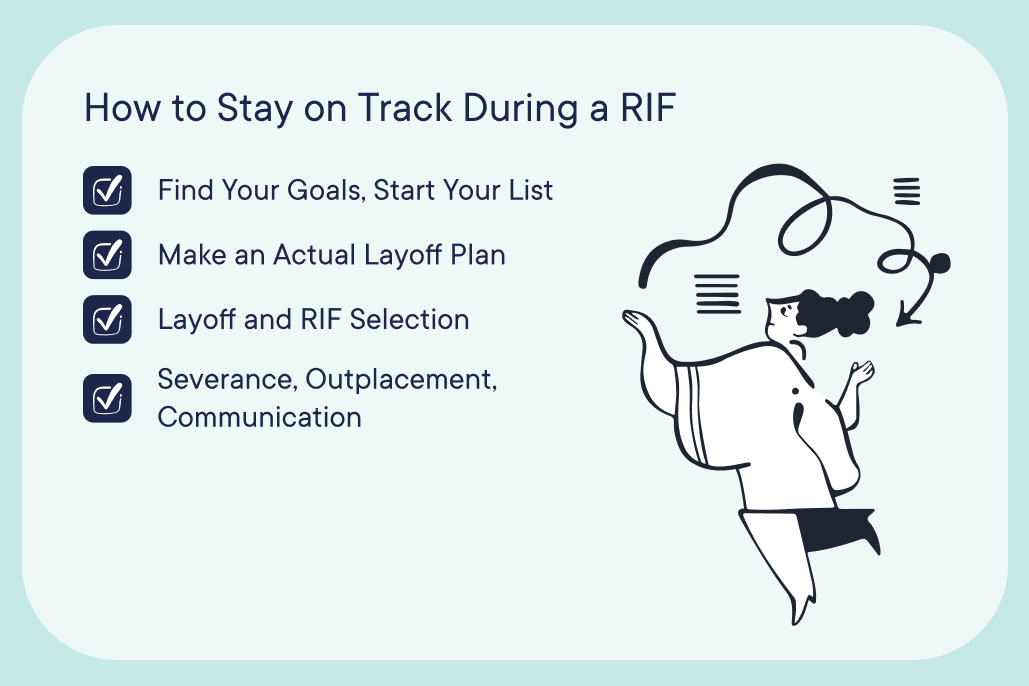
Preparing for a RIF?
Download our Essential Guide to Handling a Layoff
Request Pricing
Compare our rates to other providers
When you need to downsize your organization, it helps to keep everything running smoothly with a good, old fashioned reduction in force (RIF) checklist.
Yup, even with an increased amount of technological tools available, a printable (or digitally editable) RIF checklist will help you stay on track, analyze all of the possible options and outcomes, and – most importantly – will make the event go over as smoothly as possible.
Reductions in force or even layoffs are incredibly stressful for everyone involved. By making sure you hit all of the proper actions in the proper order, you will get through the event without all of the headaches.
You can download our checklist here:
Let’s dig into some details.
Step One: Find Your Goals, Start Your List
As SHRM states, it is valuable to break your RIF checklist into sections to keep everything as easy to follow as possible.
The first step – or section – is to identify your goals and business objectives. This section should help you look into why you are holding the event, if the event is the right thing to do, how the event will fix your organizational problems, and then dig into where the reduction will take place.
You should also look into layoff or RIF alternatives, too.
Once you have figured out that the RIF or layoff is the right move for your company, it’s time to identify where the RIF should take place and also start looking into how the public will view your move.
It’s important to control how layoff news comes out. You don’t want to hurt your public reputation, hurting your bottom line in the process. You need to keep up with how the public (and your retained and let go employees) feel about your move.
Here’s a brief list of what you should ask yourself in this section of the list:
- What outcome do you want to achieve? (What is the problem?)
- Are there alternatives? (Furloughs, temporary layoffs, etc)
- Is this the right time to hold an event like this?
- What positions will be impacted by the move? (Locations, departments, teams, etc)
- What will this achieve?
- How do you control the public narrative? (Give your outbound employees the red carpet treatment, help retained employees with their survivor guilt, etc.)
Next up, it’s time to start looking into the actual plan to understand how your event will play out in reality.
Step Two: Make an Actual Layoff Plan
This is the part of the checklist that gets into the nitty gritty detail of how the layoff should go. We’ve covered many aspects of RIFs and layoffs in the past. You can check out our guides specifically about RIFs (the permanent version of layoffs) here:
First, you’ll need to figure out what team is going to identify those being let go, what locations will be impacted, set goals based on analytics that dig into how many people need to be impacted, and how that will work towards stabilizing your business goals.
Next, create a timeline, examine if you need to take any other budgetary steps (bonus cancellation, hiring freeze, etc).
Finally, you need to remember to draft a plan on paper for your legal counsel to look over. There are tons of rules on the books to make sure employees are not terminated inappropriately, especially for workers over 40 years old.
Here’s a brief list of what this section will look like:
- Create your team. Talk with managers, executives, accountants, etc, to identify where cuts can be made and what those cuts will achieve.
- Get a better understanding of how many cuts need made. Where these cuts will happen (locations, teams, etc).
- Reexamine if there are other courses of actions. Can you hold a voluntary RIF? Voluntary retirement? Any of reduction that can be done voluntarily should be thoroughly inspected.
- Completely lay out your budget to make sure your plan hits all of the proper places and gets you back on track. There is no point holding a RIF if you are still going to be in the weeds when it’s over.
- Create a an initial timeline.
- Put everything into a document that is sent to your legal team for review to make sure you are following all local, state, and federal laws.
Next up, develop the exact details that will help you choose who will be impacted by the RIF.
Step Three: Layoff and RIF Selection
We’ve covered a bunch of different ways to select employees for a layoff. Many of them incorporate a bunch of different criteria. You can read more about them here.
In short, there are countless ways to select employees for a RIF, but all of them have to be data-driven.
After you determine your criteria, make sure to let your legal counsel review it so that you are completely compliant.
Here’s how this section of the checklist might look:
- Establish criteria. You can use this guide to help.
- Create a team to go through this process.
- Create a list for the event, make sure your team goes over them all.
- Review, review, review.
- Start the process after finalizing the list. Make sure you always talk to your legal team throughout the whole process.
- Review WARN Act issues.
- Prepare notices. (Learn more about WARN Act notices and how to send them here.)
Step Four: Severance, Outplacement, Communication, and More
This step is all about what happens immediately after the RIF.
For example, you need to make sure you have a well-rounded, and well-crafted, severance agreement that goes over the termination in detail and protects you from potential lawsuits.
You should also offer outplacement services to your exiting staff members to make sure that they land on their feet in a new role at another organization. Outplacement also helps protect your organization’s reputation during these trying times.
At the same time, you need to make sure all of these moves follow regulations that protect workers, especially those over 40 years old.
Then, you need to make sure all of your communication is on point. Prepare your notification letters, how you will talk to your retained staff, and how you will meet with those being let go to discuss benefits and other changes.
Here’s how this section of the checklist might look:
- Create and explore severance agreements (pay special attention to employees who are in protected groups).
- Create all communication materials. (Layoff letters, notification letters, memos, etc)
- Establish a way for staff members to meet with you. Also, prepare meeting times to notify those being let go. Learn more about how to hold a layoff or RIF meeting here.
- Actually hold the meeting(s).
- Hold meetings and provide communication to survivors after the event.

A Reduction in Force Checklist: The Final Say
When it comes to RIFs, there’s a lot going on.
You need to make sure that you hit all of the steps in the proper order to ensure that your organization comes out of the event more aligned to their business goals without a tarnished reputation.
In need of outplacement assistance?
At Careerminds, we care about people first. That’s why we offer personalized talent management solutions for every level at lower costs, globally.


